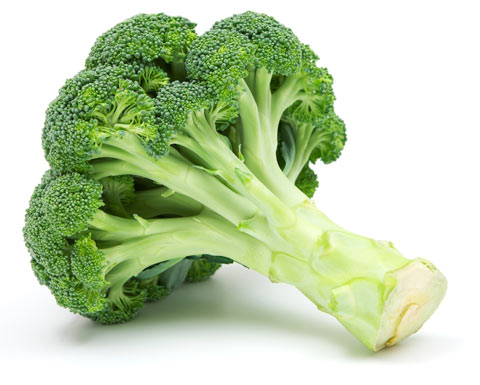Effects of Broccoli on Cancer

Fun Facts: (i.7)
When you eat broccoli you are actually eating a flower!
Broccoli contains carotenes — the pigments that make carrots orange — but it's the chlorophyll pigments that make broccoli green.
Broccoli (Brassica oleracea italica) is a member of the cruciferous plant family, which includes Brussels sprouts, cabbage, mustard greens, cauliflower, turnips, and kale. Ancient Romans developed broccoli from wild cabbage, but only began to be grown commercially in the United States in the 1920s. You can find broccoli in either the more familiar broccoli head or as immature sprouts. (i.1-3)
Evidence of Broccoli's Cancer-Fighting Benefits
Population studies have consistently shown that people who eat a lot of broccoli are linked to lower rates of these types of cancers: (i.4)
Beneficial Micronutrients in Broccoli
Both heads and sprouts are high in vitamin C and vitamin A. In fact, a serving of steamed broccoli contains far more vitamin C than an orange. But a cup or two of sprouts contains as much of the antioxidant sulforaphane glucosinolate as over 100 pounds of broccoli heads. This antioxidant has been shown to block the growth of breast and prostate cancer cells in lab studies, while other sulfurous substances in broccoli inhibited thyroid cancer. (i.1, 2)
Other nutrients in fiber-dense broccoli include: (i.3-6)
|
Indole-3-carbonol (I3C) is a compound with antioxidant properties. Lab and animal studies demonstrate that indoles regulate estrogen hormone levels in ways that can block tumor growth. Results of human studies suggest that I3C can prevent precancerous lesions in the cervix and throat. (i.3, 4)
What to Look for When Buying Broccoli
In the United States, fresh broccoli is considered to be in season June through December. However, during the winter months it's in season and available in the states of Arizona, Florida, Texas, and Washington. (i.1, 7)
You can also find broccoli in the frozen foods section of most grocery stores.
| Choose (i.7) | Avoid (i.7) |
|---|---|
| Dark green and/or purplish color heads. | Yellow heads. |
| Tightly closed buds on florets. | Any signs of buds opening on florets. |
| Light green stems. | Pale (without any green color), dry stems. |
As with most fresh produce that isn't a root or bulb vegetable (e.g., carrots, onions, and potatoes), storage time after harvesting is typically only a few weeks. This means that by the time you buy it from a retail grocer, you really should plan on using it within 1-2 days for the best taste and maximum nutrition. (i.1, 8)
How to Prepare Broccoli
When served plain, broccoli is typically steamed, boiled, or served raw as part of a fresh veggie platter. Cut off the thickest part of the stalk and discard, using just the florets and the smaller stems. Or you can peel the thick fibrous (which is indigestible anyway) outer layer of the stalk and cut up the interior portion into smaller pieces to use. (i.1, 7)
One recent study indicates that raw or lightly steamed are the best options to get the most out of antioxidant-rich broccoli. Microwaving and boiling in water until fully cooked both leach out essential nutrients into the cooking water. (i.9)
Other studies indicate microwaving broccoli for two minutes, until only lightly cooked, is better than cooking until it is thoroughly tender. This study also showed that you don't have to give up your favorite Chinese beef-and-broccoli dishes for fear that mixing meat with broccoli will interfere with antioxidant levels or absorption. And stir-frying is a good way to prepare broccoli to that slightly cooked, crisp yet tender stage that maximizes its cancer-fighting properties. (i.1, 10)
While length of cooking time appears to be the primary factor in keeping nutrient levels high in cruciferous vegetables, this doesn't necessarily mean that eating broccoli raw is better (although some experts suggest raw is best). In fact, researchers at the University of Illinois discovered that cooking broccoli slightly appears to increase the level of available cancer-fighting sulforaphanes. (i.1, 5, 10)
Raw or cooked, at less than 45 calories per one-cup serving size broccoli is ideal for dieting. (i.5) With its high fiber content you're sure to feel full faster, too.
Growing Broccoli at Home (i.11)
Cruciferous vegetables grow well in regions with cooler seasons, and even need a little (1-2 weeks) of cold-enough-for-frost weather to do really well. In temperate regions, you can plant two crops a year — one to harvest in the early summer and another planted as the weather cools in late summer to harvest in the autumn.
For best growing results, plant broccoli in well-drained soil with a pH of 7.2 to avoid fungal problems. Broccoli needs a lot of fertilizer. Apply once when you plant and fertilize again every 30 days until harvest. Organic fertilizers such as composted plant debris, manure, or made from seafood byproducts are generally better for your soil and for the fruits and vegetables grown in it since they contain many beneficial trace substances. Use straw as an organic mulch for your seed beds or transplanted seedlings.
Next, be sure to keep an eye out for the pests that can ravage through your broccoli garden quickly if left on the plants:
- Bright green, white-striped cabbage looper caterpillars that come from grey moths.
- Fuzzy green caterpillars that come from the yellow eggs laid by pretty white cabbage moths with a black dot marking each wing.
There are lots of organic options to control these cruciferous veggie-loving pests. Simply draping a lightweight, permeable fabric over the planted rows early in the season can prevent moths from laying eggs on the leaves of your plants. The covers are staked down to prevent them from blowing away but still loose enough to give the plants room to grow.
If you do find some unwanted hungry insects on your plants, one of the easiest ways to get rid of them is to pick or knock off by hand and discard into a can of soapy water. You can also spray plants with Bacillus thuringiensis, naturally occurring bacteria found in most soil that infects and kills caterpillars.
| Do's | Don'ts |
|---|---|
| Plant more than one crop a year of broccoli — one in early spring and one in late summer. | Plant near other cruciferous veggies (e.g., kale, cabbage) which are all vulnerable to the same pests and diseases. |
| Rotate crop planting from one area to another each season. | Let the plants go too long before harvesting — after the plant starts to flower by turning yellow, the broccoli flower heads will taste bitter. |
| Harvest when flower heads are still bunched and green. | Wait too long before covering your plants — as soon as you see those little white moths fluttering around your garden you know they're looking for a nice broccoli plant to lay their eggs on. |



